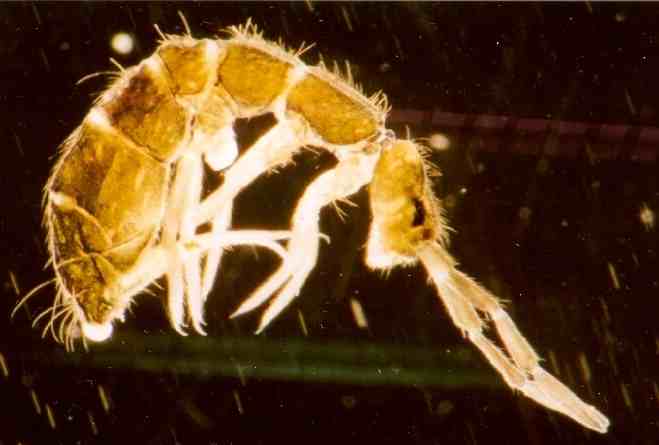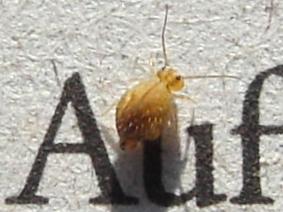|
Neelipleona
Neelipleona is a name given to some hexapods of the subclass Collembola (springtails). While their taxonomic rank remains broadly settled as family Neelidae, Neelipleona has been described at order or suborder rank. Eyes are absent. Taxonomic rank Many authors consider the "Neelipleona" Symphypleona of the superfamily Sminthuroidea, family Neelidae.See references in Haaramo (2008) However, in other accounts, Neelipleona are either a distinct order from the three less controversial Springtail orders (Entomobryomorpha, Poduromorpha and Symphypleona) or a distinct suborder Order () is one of the eight major hierarchical taxonomic ranks in Linnaean taxonomy. It is classified between family and class. In biological classification, the order is a taxonomic rank used in the classification of organisms and recognized ... of Symphypleona, or placed in the Entomobryomorpha. References Footnotes Collembola {{springtail-stub ... [...More Info...] [...Related Items...] OR: [Wikipedia] [Google] [Baidu] |
Springtail
Springtails (class Collembola) form the largest of the three lineages of modern Hexapoda, hexapods that are no longer considered insects. Although the three lineages are sometimes grouped together in a class called Entognatha because they have internal Arthropod mouthparts, mouthparts, they do not appear to be any more closely related to one another than they are to insects, which have external mouthparts. Springtails are omnivorous, free-living organisms that prefer moist conditions. They do not directly engage in the decomposition of organic matter, but contribute to it indirectly through the fragmentation of organic matter and the control of soil microbial communities. The word ''Collembola'' is from Ancient Greek 'glue' and 'peg'; this name was given due to the existence of the collophore, which was previously thought to stick to surfaces to stabilize the creature. Early DNA sequence studies suggested that Collembola represent a separate Lineage (evolution), evolutionary ... [...More Info...] [...Related Items...] OR: [Wikipedia] [Google] [Baidu] |
Neelidae
Neelidae is a family of springtails in the order Neelipleona. There are at least 4 genera and more than 30 described species in Neelidae. Genera These four genera belong to the family Neelidae: * ''Megalothorax'' Willem, 1900 * ''Neelides'' Caroli, 1912 * ''Neelus'' Folsom, 1896 * ''Zelandothorax'' Delamare Debouteville & Massoud, 1963 Description Members of the family Neelidae are generally minute, averaging around 500 μm. They possess globular bodies superficially like that of the Symphypleona, with relatively long legs and a well-developed Furcula (springtail), furca compared to other soil-dwelling springtails. Phylogeny Neelidae was initially considered to have a close affinity with Symphypleona, based on morphological characteristics shared between the two groups such as a globular shape, neosminthuroid setae and others. However, molecular data places them as a basal group to all other Collembola. References Further reading * External links * Collem ... [...More Info...] [...Related Items...] OR: [Wikipedia] [Google] [Baidu] |
Symphypleona
The order Symphypleona, also known as the globular springtails, is one of the three main groups of springtails (Collembola), tiny hexapods related to insects. When the springtails were still believed to be an order of insects, the Symphypleona were ranked as a suborder. They can be best distinguished from the other springtail groups by their body shape. The Symphypleona are very round animals, almost spherical, and usually have long antennae. The Poduromorpha, by contrast, always have short legs and a plump body, but more oval in shape than the Symphypleona. The Entomobryomorpha are the slimmest springtails, some with long and some with short legs and antennae, but always with a very slender body. Systematics The Symphypleona order was previously suggested to also contain family Neelidae, as a very apomorphic relative in the Sminthuridae superfamily. Phylogenetic studies however suggest Neelidae to be the only family of Neelipleona order.Gao, Yan; Bu, Yun & Luan, Yun-X ... [...More Info...] [...Related Items...] OR: [Wikipedia] [Google] [Baidu] |
Sminthuroidea
The order Symphypleona, also known as the globular springtails, is one of the three main groups of springtails (Collembola), tiny hexapods related to insects. When the springtails were still believed to be an order of insects, the Symphypleona were ranked as a suborder. They can be best distinguished from the other springtail groups by their body shape. The Symphypleona are very round animals, almost spherical, and usually have long antennae. The Poduromorpha, by contrast, always have short legs and a plump body, but more oval in shape than the Symphypleona. The Entomobryomorpha are the slimmest springtails, some with long and some with short legs and antennae, but always with a very slender body. Systematics The Symphypleona order was previously suggested to also contain family Neelidae, as a very apomorphic relative in the Sminthuridae superfamily. Phylogenetic studies however suggest Neelidae to be the only family of Neelipleona order.Gao, Yan; Bu, Yun & Luan, Y ... [...More Info...] [...Related Items...] OR: [Wikipedia] [Google] [Baidu] |
Neelus Murinus
''Neelus'' is a genus of springtails within the family Neelidae. Members of this genus can be found in Europe and North America North America is a continent in the Northern Hemisphere, Northern and Western Hemisphere, Western hemispheres. North America is bordered to the north by the Arctic Ocean, to the east by the Atlantic Ocean, to the southeast by South Ameri .... Species * '' Neelus cvitanovici'' V. Papác, M. Lukic & L. Kovác, 2016 * '' Neelus desantisi'' Najt, 1971 * '' Neelus fimbriatus'' Bretfeld & Trinklein, 2000 * '' Neelus incertoides'' Mills, 1934 * '' Neelus incertus'' (Boener, 1903) * '' Neelus klisurensis'' L. Kovác & V. Papác, 2010 * '' Neelus koseli'' L. Kovác & V.Papác, 2010 * '' Neelus labralisetosus'' Massoud & Vannier, 1967 * '' Neelus lackovici'' V. Papác, M. Lukic & L. Kovác, 2016 * '' Neelus murinus'' J. W. Folsom, 1896 * '' Neelus snideri'' (Bernard, 1975) References {{Taxonbar, from=Q10595699 Collembola Springtail genera ... [...More Info...] [...Related Items...] OR: [Wikipedia] [Google] [Baidu] |
Hexapoda
The subphylum Hexapoda (from Greek for 'six legs') or hexapods comprises the largest clade of arthropods and includes most of the extant arthropod species. It includes the crown group class Insecta (true insects), as well as the much smaller clade Entognatha, which includes three classes of wingless arthropods that were once considered insects: Collembola (springtails), Protura (coneheads) and Diplura (two-pronged bristletails). The insects and springtails are very abundant and are some of the most important pollinators, basal consumers, scavengers/ detritivores and micropredators in terrestrial environments. Hexapods are named for their most distinctive feature: a three-part body plan with a consolidated thorax and three pairs of legs. Most other arthropods have more than three pairs of legs. Most recent studies have recovered Hexapoda as a subgroup of Pancrustacea. Morphology Hexapods have bodies ranging in length from 0.5 mm to over 300 mm which are divided ... [...More Info...] [...Related Items...] OR: [Wikipedia] [Google] [Baidu] |
Subclass (biology)
In Taxonomy (biology), biological classification, class () is a taxonomic rank, as well as a taxonomic unit, a taxon, in that rank. It is a group of related taxonomic orders. Other well-known ranks in descending order of size are Domain (biology), domain, Kingdom (biology), kingdom, phylum, Order (biology), order, Family (biology), family, genus, and species, with class ranking between phylum and order. History The class as a distinct rank of biological classification having its own distinctive name – and not just called a ''top-level genus'' ''(genus summum)'' – was first introduced by France, French botanist Joseph Pitton de Tournefort in the classification of plants that appeared in his ''Eléments de botanique'' of 1694. Insofar as a general definition of a class is available, it has historically been conceived as embracing taxa that combine a distinct ''grade'' of organization—i.e. a 'level of complexity', measured in terms of how differentiated their organ systems ... [...More Info...] [...Related Items...] OR: [Wikipedia] [Google] [Baidu] |
Taxonomic Rank
In biology, taxonomic rank (which some authors prefer to call nomenclatural rank because ranking is part of nomenclature rather than taxonomy proper, according to some definitions of these terms) is the relative or absolute level of a group of organisms (a ''taxon'') in a hierarchy that reflects evolutionary relationships. Thus, the most inclusive clades (such as Eukarya and Animalia) have the highest ranks, whereas the least inclusive ones (such as ''Homo sapiens'' or ''Bufo bufo'') have the lowest ranks. Ranks can be either relative and be denoted by an indented taxonomy in which the level of indentation reflects the rank, or absolute, in which various terms, such as species, genus, Family (biology), family, Order (biology), order, Class (biology), class, Phylum (biology), phylum, Kingdom (biology), kingdom, and Domain (biology), domain designate rank. This page emphasizes absolute ranks and the rank-based codes (the International Code of Zoological Nomenclature, Zoological Code, ... [...More Info...] [...Related Items...] OR: [Wikipedia] [Google] [Baidu] |
Family (biology)
Family (, : ) is one of the eight major hierarchical taxonomic ranks in Linnaean taxonomy. It is classified between order and genus. A family may be divided into subfamilies, which are intermediate ranks between the ranks of family and genus. The official family names are Latin in origin; however, popular names are often used: for example, walnut trees and hickory trees belong to the family Juglandaceae, but that family is commonly referred to as the "walnut family". The delineation of what constitutes a family—or whether a described family should be acknowledged—is established and decided upon by active taxonomists. There are not strict regulations for outlining or acknowledging a family, yet in the realm of plants, these classifications often rely on both the vegetative and reproductive characteristics of plant species. Taxonomists frequently hold varying perspectives on these descriptions, leading to a lack of widespread consensus within the scientific community ... [...More Info...] [...Related Items...] OR: [Wikipedia] [Google] [Baidu] |
Order (biology)
Order () is one of the eight major hierarchical taxonomic ranks in Linnaean taxonomy. It is classified between family and class. In biological classification, the order is a taxonomic rank used in the classification of organisms and recognized by the nomenclature codes. An immediately higher rank, superorder, is sometimes added directly above order, with suborder directly beneath order. An order can also be defined as a group of related families. What does and does not belong to each order is determined by a taxonomist, as is whether a particular order should be recognized at all. Often there is no exact agreement, with different taxonomists each taking a different position. There are no hard rules that a taxonomist needs to follow in describing or recognizing an order. Some taxa are accepted almost universally, while others are recognized only rarely. The name of an order is usually written with a capital letter. For some groups of organisms, their orders may follow consist ... [...More Info...] [...Related Items...] OR: [Wikipedia] [Google] [Baidu] |
Entomobryomorpha
The Entomobryomorpha are one of the three main groups (order) of springtails (Collembola), tiny hexapods related to insects. This group was formerly treated as a superfamily, the Entomobryoidea. They can be best distinguished from the other springtail groups by their body shape. The Symphypleona are very round animals, almost spherical. The Poduromorpha are also very plump but have a more oval shape. The Entomobryomorpha, by contrast, contain the slimmest springtails. They either have short legs and antennae, but their long bodies set them apart, or long legs and antennae, as well as well-developed furculae; these are the most characteristic members of the order. Systematics The Entomobryomorpha were, as Entomobryoidea, united with the Poduromorpha (then called Poduroidea) in a group called "Arthropleona", but this has more recently turned out to be paraphyletic. Actually, the Entomobryomorpha, the Poduromorpha, and the third springtaill lineage – the Symphypleona – are ... [...More Info...] [...Related Items...] OR: [Wikipedia] [Google] [Baidu] |





